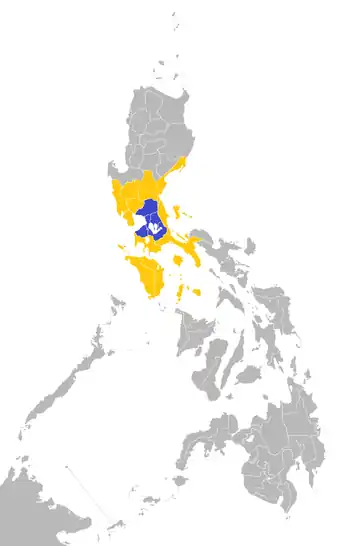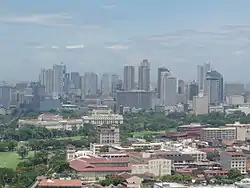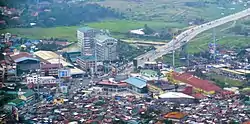Mega Manila
Mega Manila is the megalopolis in the Philippine regions of Central Luzon, Calabarzon, Mimaropa and Metro Manila. It is frequently used in the press, advertising, television, and radio to refer to provinces bound to Manila, in contrast to the term Greater Manila Area, which is academically used to describe the urbanization process that has long spilled out of Metro Manila's borders, also known as the built-up area. Mapping out the built-up area around Manila requires finer granularity than the more generic term Mega Manila.


Mega Manila is used in general reference to the relationship of Metro Manila to surrounding provinces. It references only provinces and not the exact settlement patterns of cities, towns, and barangays, which may be urban, suburban, mountains, or rural areas that are still part of provinces close enough to Manila to be lumped into the definition.
Definitions
Philippine Information Agency
Mega Manila, as a loose metropolitan area defined by the Philippine Information Agency (PIA),[1] is divided into the national capital region (Metro Manila) and the suburbs of regions 3 (Central Luzon) and 4 (Calabarzon and Mimaropa). Mega Manila's 2015 population is projected at 40,368,979 or 40% of the country's population, and covers roughly half of Luzon, with an area of 52,097.66 square kilometers, including many rural areas.
TV rating companies
TV ratings agency AGB Nielsen Philippines and Kantar Media Philippines consider Metro Manila and the provinces of Bulacan, Cavite, Laguna and Rizal as "Mega Manila"[2] for their TV ratings gathering (area highlighted in blue on the map), a much stricter definition than the PIA. Using census population in 2010[3] the area has a population of 25,066,000 or about 26.6% of the population in an area roughly the size of Los Angeles County and average density over 2000 people per square kilometer. As a comparison, only the cities of Tokyo, Jakarta, and Mexico City have reached 25 million people, Shanghai may have but there is not enough detail in suburban statistics on it. Both Mega Manila definitions only include entire provinces, without finer detail.
This Nielsen defined area has a higher ownership of televisions per household anywhere in the country due to its relative economic prosperity as compared to other areas in the country. Radio ratings agency Radio Research Council (provided by KBP) also provide measurement of audience ratings.
The stricter Nielsen definition closer reflects the built-up area surrounding Manila than the PIA definition, Yet even the Nielsen definition of Mega Manila cannot be merely equated to the built-up area; the Nielsen definition includes significant undeveloped forested areas, while completely excluding contiguous developed settlements in such places like northern Batangas. Thus the academic definition as used for urban studies for built-up area surrounding Manila requires yet another term (e.g. Greater Manila Area) to disambiguate from the already used terms Mega Manila and Metro Manila.
